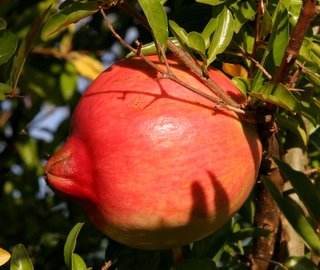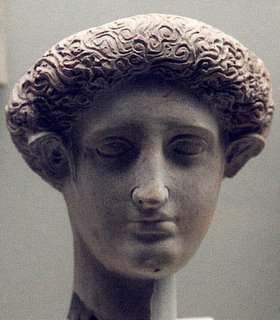
Never has so much responsibility been placed in a fruit. Pomegranate S.L. is the name of our new company and Granada (where we've moved to) is the Spanish name for the fruit. So, if this whole move to Spain goes wrong at least we’ll be able to blame some other fruit.
Given all of the above, I thought it was time to cook something with pomegranate. This recipe comes from Blanca’s friend, Sofia Craxton’s “The Mexican Mama’s Kitchen: Authentic Homestyle Recipes”.

Along with cactus pear, dates, figs and jujube, McGee[i] defines pomegranate as a fruit from arid climates. It was brought to Spain in the ninth century by the Moors. They named their kingdom after the fruit. Missionaries from Spain introduced the fruit to the Caribbean and Latin America in the 1700-1800’s. Today it is principally found in the Mediterranean and western Asia (with the best said to come from Iran). McGee rattles off a few adjectives in association with pomegranates that, honestly, leave me a little confused:
- very sweet – tasting of sugar
- fairly tart – sharp to the taste; acid; sour
- astringent – chemical substance that tends to shrink or constrict body tissues (incidentally a taste that is not detected by birds)
[ii]Jewish tradition teaches it as a symbol of righteousness due to the fact that it is said to have 613 seeds corresponding to the 613 commandments (mitzvot) of the Torah. It is often eating on Rosh Hashanah (Jewish new year for people, animals and, appropriately, legal contracts).

[iii]In a plot that makes the average Spanish Telenovela look tame, Persephone, in Greek mythology the queen of the dead, was said to have been damned to a month every year in hell for every pomegranate seed she ate. She was the daughter of Zeus and Demeter (goddess of the earth) who was abducted by Hades (god of the underworld). In her grief, Demeter became distracted and as a result life on earth came to a standstill. In order to save the world, Zeus ordered Hades to return his daughter. Before being returned, Hades tricked Persephone into eating 6 pomegranate seeds, thereby being condemned to return to the underworld for the same amount of months every year. For this reason, the earth flourishes with vegetation for the 6 months of mother and daughter unity every year.

I honestly never thought that I would get a picture of a grenade into a blog...
On a rather more prosaic note, the hand grenade gets its name from the pomegranate. The seeds of the pomegranate burst forth with juice in a similar manner to the grenade’s fragments. The juice of the pomegranate stains permanently, whilst the grenade can have similar long-term effects.
One pomegranate myth that is not true relates to the English. Some sources believe that Australians call the English POMS either due to the fact that they have a habit of turning red in the sun or that they came on boats that were also carrying pomegranates. The name in fact comes from Prisoner of Mother England.

The arils (seed casing) are surrounded by a rind that is rich in tannins and very bitter. So much so that it was once used in tanning leather. Each fruitlet contains one prominent seed which is used “as is” or cooked into a molasses, or fermented into wine. A ripe pomegranate spurts juice as soon as it is pierced, for this reason Blanca showed me the “beat it with a rolling pin” technique. This highly sophisticated method involves cutting the fruit in half and beating each half with a pin in order to dislodge the seeds. Note: a baseball bat could be used for this purpose.
Ingredients (for 4):
2 seabass
1 ½ large pomegranates
1 tsp sugar
Juice of ½ lemon
1 cup basmati rice
½ cup coconut milk
1 cup water
Butter
Salt and pepper
Olive oil
2 seabass
1 ½ large pomegranates
1 tsp sugar
Juice of ½ lemon
1 cup basmati rice
½ cup coconut milk
1 cup water
Butter
Salt and pepper
Olive oil
Sofia agrees that pomegranates came to Mexico from Spain. They are in season from September to December. This innovative recipe needs only 20 minutes of preparation to produce a really original taste.
Extract the seeds (reserve some for garnish) and blend with the sugar and lemon until pureed. Place the fillets on their own sheets of aluminium foil. Season with salt and pepper. Pour the sauce over and drizzle with olive oil. Close the parcels, ensuring that the edges are well sealed. Bake in a 180 C oven for about 15 minutes until the fillets are cooked.
Pomegranate seeds lose their colour during cooking, it is important to garnish the cooked fillets prior to serving.
Sofia recommends serving this dish with white rice. In Mexico this is a traditional partner for fish dishes. We cooked the lighter version; melt the butter, add the milk and water and bring to the boil. Add the rice, bring back to the boil, cover and simmer for 10 minutes, leaving to rest before serving.
Sources:
[i] Harold McGee “McGee on Food & Cooking An encyclopedia of kitchen science, history and culture”
[ii] Wikipedia
[iii] Stephanie Alexander “The cook’s companion”




1 comment:
I like your article talk about pomegranate, I have written too about the power of pomegranate for the body, you can visit my website anytime to check it
Post a Comment